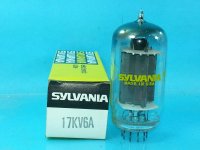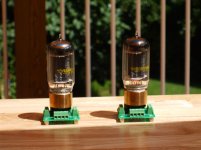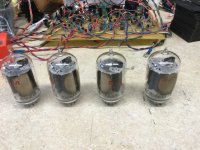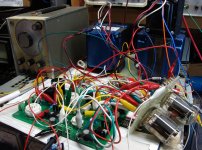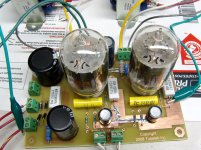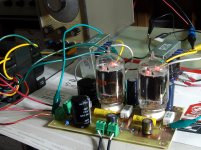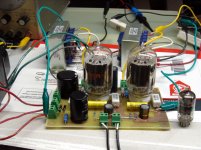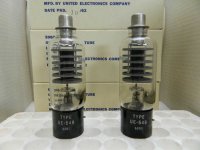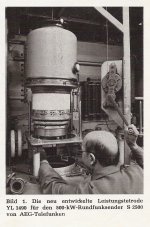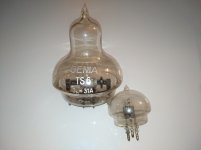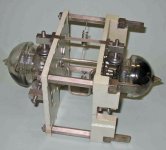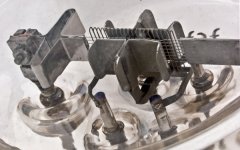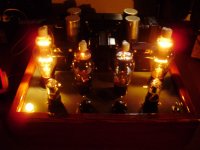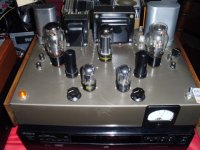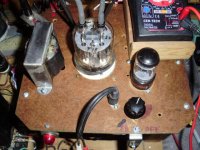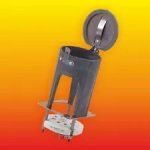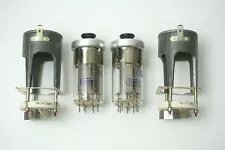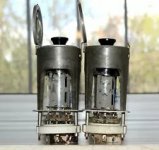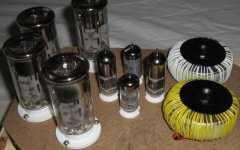The real thing
Maybe 100 watts of power dissipation capability, but *no nipples*.
Well, you should use 17KV6a tubes for an audio amp then.
I seem to recall someone making a DIY amplifier that had two rounded cup like extensions on the front panel for control knobs. It got more than a few snide remarks. Maybe could do the same with 17KV6 tubes mounted there! Could mount the tube sockets on touch sensitive rocker switches inside, for incremental up/down volume controls too.
I seem to recall someone making a DIY amplifier that had two rounded cup like extensions on the front panel for control knobs. It got more than a few snide remarks. Maybe could do the same with 17KV6 tubes mounted there! Could mount the tube sockets on touch sensitive rocker switches inside, for incremental up/down volume controls too.
Attachments
Last edited:
All Sylvania-type Novars have the nipple^H^H^H^H^H^Hexhaust tip on top. I bought a less-expensive Horga’an one time I was on Risa (vacuumtubes.net) but it did fetch me this exquisite display pair for a good price. They are with-child - 12AT7 type triode along for the ride.
Tube porn. A new low for us all. Certainly not whacky tubes, but whacky owners with dirty minds for sure.
What kind of current at max Vg2 are the KV6’s good for? Not finding that much info. I do keep pretty tubes in mind when making a haul. And I see the 6 volt version are a bit pricey for a 20 watt TV tube.
Tube porn. A new low for us all. Certainly not whacky tubes, but whacky owners with dirty minds for sure.
What kind of current at max Vg2 are the KV6’s good for? Not finding that much info. I do keep pretty tubes in mind when making a haul. And I see the 6 volt version are a bit pricey for a 20 watt TV tube.
Attachments
Warm nipples.....The little cold one IS a 12AT7.
This actually started out as an SSE board, a Novar turret board and a box full of clip leads. This was an exercise in how NOT to design an amp, yet it worker perfectly at first power up.
This actually started out as an SSE board, a Novar turret board and a box full of clip leads. This was an exercise in how NOT to design an amp, yet it worker perfectly at first power up.
Attachments
6/17/22KV6 tube ratings
(as a regulator tube):
cathode current: 275mA DC, 950 mA peak
screen grid voltage: 220V max, 2 Watts max
plate supply voltage: 900V max, 28 Watts max
gm 6000 @ 40 mA
rp 10000 @ 40 Ma
mu 4
(as a Horiz. Sweep tube):
cathode current: 275mA DC, 950 mA peak
screen grid voltage: 220V, 3.5 Watts max
plate supply voltage: 900V max, 22 Watts max
gm 9500 @ 80 mA
rp 6000 @ 80 mA
mu 4
The tube started out as a revised 6KM6 for HV pulse regulator use (TV)
Then got some mods for the A version for controlled warmup (11 sec.) with a cooler fin added to grid 1, and the ratings re-done for regulator use.
Plate curves are very similar to 21HB5A, 6JG6, 6KM6
ratings are similar to 6HJ5, 6DQ5
internal capacitances: Cg1-p 0.6 pF
Ci 22 pF
Co 9 pF
note: 17KV6 uses 16.8V for the heater
Operating:
(g1 at 0V): DC plate 100V 440 mA, screen 140V 30 mA
(g1 at -24.5V): DC plate 140V 40 mA, screen 140V 2.4 mA
As I recall, 17KV6 were on sale at Antique Elect. years ago at like $2 or $3
6KV6 is expensive.
Porn or no porn, I like the seal tip up top, more than a plate cap up top. Looks more antique. Edison bulb style.
And the tube pins aren't all burned blueish from the sealing flame.
(as a regulator tube):
cathode current: 275mA DC, 950 mA peak
screen grid voltage: 220V max, 2 Watts max
plate supply voltage: 900V max, 28 Watts max
gm 6000 @ 40 mA
rp 10000 @ 40 Ma
mu 4
(as a Horiz. Sweep tube):
cathode current: 275mA DC, 950 mA peak
screen grid voltage: 220V, 3.5 Watts max
plate supply voltage: 900V max, 22 Watts max
gm 9500 @ 80 mA
rp 6000 @ 80 mA
mu 4
The tube started out as a revised 6KM6 for HV pulse regulator use (TV)
Then got some mods for the A version for controlled warmup (11 sec.) with a cooler fin added to grid 1, and the ratings re-done for regulator use.
Plate curves are very similar to 21HB5A, 6JG6, 6KM6
ratings are similar to 6HJ5, 6DQ5
internal capacitances: Cg1-p 0.6 pF
Ci 22 pF
Co 9 pF
note: 17KV6 uses 16.8V for the heater
Operating:
(g1 at 0V): DC plate 100V 440 mA, screen 140V 30 mA
(g1 at -24.5V): DC plate 140V 40 mA, screen 140V 2.4 mA
As I recall, 17KV6 were on sale at Antique Elect. years ago at like $2 or $3
6KV6 is expensive.
Porn or no porn, I like the seal tip up top, more than a plate cap up top. Looks more antique. Edison bulb style.
And the tube pins aren't all burned blueish from the sealing flame.
Last edited:
Do you want something cheap and easily available? The 832a tube glows more than most audio tubes and a 250v power supply is enough for the low distortion triode mode. It surely draws attention. 829a is the big brother with higher power. I've built a 832a single ended amplifier mostly for the look. This tube becomes hot, the metal plate in the picture can't be touched despite the concealed aluminium heatsink at the bottom of the amplifier. There are many tubes that have a unconventional look, but I believe that price wise the 832a is a winner. It is also called GU32 , FU32 and qqe04/20 .
The 832 and the 829 both like heat radiating connectors on both plates. If you are running the plates red, then the heat radiating connectors are needed to keep the glass seal temperature down. Some VHF transmitters using these tubes use both the heat radiating connectors and forced air to keep the glass seal temperature down.
Now that SW stations are being scrapped those dinosaurs may become available cheap for DIY. https://frank.pocnet.net/sheets/065/y/YL1490.pdf
A pair of these in push-pull were used for a 500kW SW transmitter station.
Note the AF spec in the DS, as another pair in PP served as modulation amp.
Another nice feature is the "integrated boiler", useful feature for those living beyond the arctic circle, winter time is ante portas, and a full size olympic heated outdoor swimming pool is pretty much standard if you have the money to pay the electricity bill ... or own a power plant. Go green is a must however these days and even a sqare mile of solar panels won't do it. Geothermal power maybe but then, why produce electricity instead of using the hot water directly ?
Ah yes, I almost forgot, the amp is required to play your favorite songs ...
A pair of these in push-pull were used for a 500kW SW transmitter station.
Note the AF spec in the DS, as another pair in PP served as modulation amp.
Another nice feature is the "integrated boiler", useful feature for those living beyond the arctic circle, winter time is ante portas, and a full size olympic heated outdoor swimming pool is pretty much standard if you have the money to pay the electricity bill ... or own a power plant. Go green is a must however these days and even a sqare mile of solar panels won't do it. Geothermal power maybe but then, why produce electricity instead of using the hot water directly ?
Ah yes, I almost forgot, the amp is required to play your favorite songs ...
Attachments
May i suggest the GEMA TS6.
This is a WWII German radar-triode with an interesting filament (2V / 31A ; no typo....) and needs only 700V on the anode.
German naval ships had in their early RF-based rangefinders first a pair of TS1a and TS1b (comparable with the VT191 but with a 6A filament) but the shock of the main guns shattered those filaments.
So the Germans simply made everything somewhat bigger and came up with the TS6.
Interesting tubes by the way. Those TS1a and TS1b are electrically the same but have opposite pin outs so they could be used back to back in a push pull module.
Picture of a TS6 next to a VT191.
Picture of the TS6 filament.
Picture of a TS1a/b-module (hot swappable.....)
(pictures thanks to the Valve Museum).
Does this qualify as whacky ? I don't know as the engineering behind this glassware is second to none.....at least call them "non-standard".
Regards, Reinout
This is a WWII German radar-triode with an interesting filament (2V / 31A ; no typo....) and needs only 700V on the anode.
German naval ships had in their early RF-based rangefinders first a pair of TS1a and TS1b (comparable with the VT191 but with a 6A filament) but the shock of the main guns shattered those filaments.
So the Germans simply made everything somewhat bigger and came up with the TS6.
Interesting tubes by the way. Those TS1a and TS1b are electrically the same but have opposite pin outs so they could be used back to back in a push pull module.
Picture of a TS6 next to a VT191.
Picture of the TS6 filament.
Picture of a TS1a/b-module (hot swappable.....)
(pictures thanks to the Valve Museum).
Does this qualify as whacky ? I don't know as the engineering behind this glassware is second to none.....at least call them "non-standard".
Regards, Reinout
Attachments
Enemy the GU-50 with its knob on top for replacement literally on the fly. Glass so thick it is bulletproof. It looks like a cartoon character from the ‘50s.
Some of the "wackiest" tubes I found are from hamfests,,, 829Bs make a nice PP amp, I build a one channel mule, but never finished the stereo chassis... 6AS7s are dual triodes which also make a nice sounding amp... Also a pair of OC3 gas tube make nice screen regulators,,, first saw them on a RCA/movie amp I rebuilt, and used them on a build...
But my favorites are 811s,, pic of a SE build...
But my favorites are 811s,, pic of a SE build...
Attachments
Enemy the GU-50 with its knob on top for replacement literally on the fly. Glass so thick it is bulletproof. It looks like a cartoon character from the ‘50s.
The knob is a requirement if you want to ever remove the tube from its original military socket, a die-cast barrel with lid. Not an easy on the fly operation actually as you cannot wiggle the tube ...
Knob and military cap can be removed which looks interesting, too.
Attachments
- Home
- Amplifiers
- Tubes / Valves
- What are some of the wackiest tubes?
